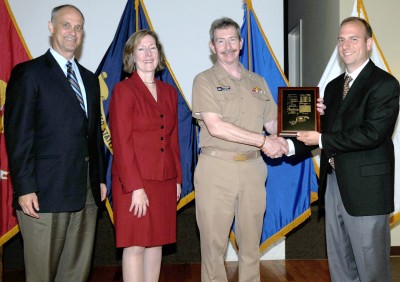
Naval Surface Warfare Center Dahlgren Division (NSWCDD) Technical Director Carl Siel, Office of Naval Research Counsel Catherine Donovan, and NSWCDD Commander Capt. Michael Smith present the NSWCDD Patent Award to Engagement Systems Department engineer Vincent Vendetti for his invention, "The Dovetail Alignment and Locking System" at the command's first Patent Awards Ceremony held in May 2012. U.S. Navy photo by Kimberly Brandts (released).
DAHLGREN, Va. - Naval Surface Warfare Center Dahlgren Division (NSWCDD) Dahlgren Division held its first Patent Awards ceremony here May 21 to recognize and honor the command's inventors and patents.
"The individuals we honor today have taken on arduous tasks to find technological solutions to challenges facing our warfighters and the Fleet," said NSWCDD Commander Capt. Michael Smith and NSWCDD Technical Director Carl Siel in the brochure listing 28 patent holders honored for 14 patents. "Through their keen observation and true genius, our patent awardees have created more effective and accurate weapon mechanisms and platforms, increased the capabilities of sensor and other systems, and enhanced physical safety."
Over the past 10 years, 154 patents have been awarded to NSWC Dahlgren personnel - top problem solvers who recognized a need, assessed the problem and persisted until they found solutions.
"You are truly the members of an elite group," keynote speaker Catherine Donovan, Counsel to the Office of Naval Research, told the awardees. "Receiving a U.S. patent is a significant event. It's a formal recognition that an invention is in a very special class of inventions - those worthy of a patent. A patent is also an opportunity to use your skills and knowledge to transfer the invention to the private sector. While patenting is a team effort, the critical team player is you, the employee inventor. You are the creator and innovator."
Capt. Smith referred to Thomas Edison's famous quote - "genius is one percent inspiration and 99 percent perspiration" - in his welcoming remarks. "Third, it takes perseverance," emphasized the NSWCDD Commander. "That is why our patent holders are key to NSWC Dahlgren's ability to meet the needs of today's warfighters and the fleet as well as to prepare for the Navy of the future."
The patents represent a culmination of effort by many individuals, including the inventors, the Invention Evaluation Board members, the patent attorneys, and others who conceive - and reduced to practice - the technological innovations arising from the command's research and development activities.
Donovan referred to President Abraham Lincoln's statement that the development of patent laws is one of the most important developments in the world's history. It "added the fuel of interest to the fire of genius," she said, quoting Lincoln.
"Clearly, in the commercial world, the ability to block others from making, using, or selling one's inventions is fundamental to the financial success of innovative businesses," said Donovan.
The ONR Counsel then cross-examined herself.
How does that cornerstone of financial profit apply to inventions made at Navy Research facilities? Why do we seek to patent our inventions?
"The taxpayer benefits, the Navy benefits, and our inventors benefit," said Donovan, citing three reasons:
-- Provide a technological return to the taxpayer by licensing our inventions to U.S. businesses so that these inventions may be commercially developed for public use.
-- Obtain defensive protection for the Navy so that others cannot obtain patents to Navy inventions and then block the Navy from using our own inventions.
-- To attain international recognition, and potential financial remuneration, for the inventors of useful, novel, and non-obvious inventions.
Capt. Smith pointed out that the patents also ensure the Navy's ability to integrate complex systems and work smarter in addition to saving time and money.


